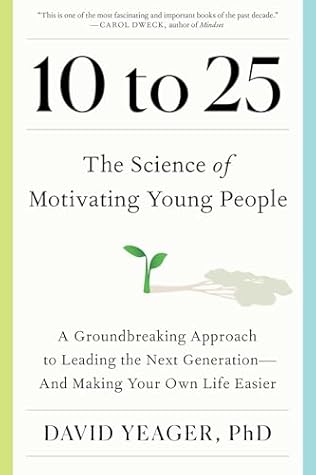More on this book
Kindle Notes & Highlights
by
David Yeager
Read between
April 24 - July 16, 2025
The logic underlying this approach is that it’s usually easier to change behavior by aligning the behavior with something people already care about than by trying to get them to care about something different.
This result confirms a major flaw in the neurobiological-incompetence model. Instead of thinking of the adolescent brain as fundamentally flawed due to puberty’s hormones, we can think of it as ready to change in response to the prospect of status and respect. We harnessed that readiness by reframing healthy behavior in line with adolescent values.
Could connecting learning tasks to a beyond-the-self purpose spur a motivation for deeper learning?
Our purpose experiment showed that if you encourage a meaningful purpose for learning—one that involves both contribution to others and the status and respect one can gain from having stronger skills—then you can motivate young people to show the discipline and hard work that adults usually fail to see when they follow a conventional approach.
And the source of beyond-the-self purpose that helps motivate them doesn’t have to just be community service—Frankl noted that a commitment to art or science or beauty can work as well.
If the only students who can benefit from a professor’s teaching are the ones who can substitute their own resources to make up for his many flaws, then that’s exclusive excellence, not inclusive excellence.
students—especially students from groups who are made to question their belonging and have a greater likelihood of dropping out—have far more agency and ability to belong than society gives them credit for. They needed to alleviate constant threats to their belonging.
Instead, the problem is they often use these skills to strike the right balance of meanness and plausible deniability.
Hatred is a destructive and corrosive emotion that grows out of the belief that another person’s or group’s essence is fundamentally horrid and rotten to the core.
Strassun’s approach is the mentor mindset in action. He focuses on everyone meeting high standards for genuine scientific contributions, while accommodating any differences that could create roadblocks for some students.
Stassun’s mentor mindset helps us realize that any of us can hold on to our value of maintaining standards while also valuing inclusion by providing necessary supports.
Physicists were assuming something that they hadn’t proved. They assumed that the GRE math score was a measure of readiness to make professional, PhD-level contributions to the future of physics. But that’s not what the test measured. The GRE math test mostly measured applicants’ recollection of high school algebra and geometry.
The GRE tends to quantify how good your high school math teacher was, yet the quality of high school math teachers isn’t evenly distributed.
Vega’s work offers a good example of why so many people advocate for inclusive excellence. It simply empowers more great people to do more great work, maybe for the betterment of humanity. Interestingly, despite Vega’s impressive talents, her contributions to astrophysics almost didn’t happen.
We specifically wanted to understand motivation across the identity-group divide—for example, when white teachers give critical feedback to students from underrepresented minority groups, or when men critique the work of women. Our studies showed that although all students profited from wise feedback, students whose identity groups experienced marginalization or exclusion benefited even more. The wise-feedback research was why, over a quarter of a century ago, Steele wrote: [Students from underrepresented groups] should have challenging work and high standards, instead of remedial work and low
...more
Laura Vega drove this point home when she told me that the other PhD students at Vanderbilt sometimes act like the bridge-program graduates came in through the back door, as though it was easier to get in. Then she thinks about how, in the bridge program, you actually have to publish your work. She has papers where she is the lead author, and in better journals than the “front door” students. She didn’t come through the back door. She deserved her spot.
The therapist’s problem refers to the fact that it’s hard to at once help young people when they’re under our care and prepare them to apply their skills effectively after they leave our care.
“It showed me that even when I don’t have friends there, I could still find activities that I enjoyed, like painting. And even with my shyness, I can still put myself out there and do things that are out of my comfort zone. I learned a lot that I still use to this day.”


